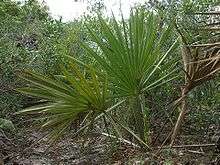Sabal etonia
| Sabal etonia | |
|---|---|
 | |
| Sabal etonia at Archbold Biological Station, Florida, United States | |
| Scientific classification | |
| Kingdom: | Plantae |
| Clade: | Angiosperms |
| Clade: | Monocots |
| Clade: | Commelinids |
| Order: | Arecales |
| Family: | Arecaceae |
| Genus: | Sabal |
| Species: | S. etonia |
| Binomial name | |
| Sabal etonia | |
| Synonyms[1] | |
Sabal etonia, commonly known as the scrub palmetto[2] is a species of palm. It is native only to peninsular Florida in the United States, where it is found in Florida sand pine scrub communities.[1][3][4]
Description
Sabal etonia is a fan palm with a solitary stem that is usually subterranean, but is sometimes above ground and up to 2 m (6.6 ft) tall. Plants usually have four to seven costapalmate leaves, each with 25–50 leaflets. The inflorescences, which are branched with a bushy appearance, are shorter than the leaves and bear brownish-black fruit. The fruit are 0.9–1.5 cm (0.4–0.6 in) and 0.8–1.3 cm (0.3–0.5 in) in diameter.[5][4]
Taxonomy
Sabal is placed in the subfamily Coryphoideae and the tribe Sabaleae.[6]
The species was first described by American botanist Walter Tennyson Swingle in 1896, based on collections made near Eustis, Florida, in 1894.[7]
Gallery
 Detail of the leaf of S. etonia
Detail of the leaf of S. etonia- Scrub palmetto in the Canaveral National Seashore
References
- 1 2 "Sabal etonia". Royal Botanic Gardens, Kew: World Checklist of Selected Plant Families. Retrieved 2009-06-01.
- ↑ "Sabal etonia". Natural Resources Conservation Service PLANTS Database. USDA. Retrieved 26 October 2015.
- ↑ Biota of North America Program 2014 county distribution map
- 1 2 Flora of North America Vol. 22 Page 108 Scrub palmetto, dwarf palmetto Sabal etonia Swingle ex Nash, Bulletin of the Torrey Botanical Club. 23: 99. 1896.
- ↑ Henderson, Andrew; Gloria Galeano; Rodrigo Bernal (1995). Field Guide to the Palms of the Americas. Princeton, New Jersey: Princeton University Press. p. 65. ISBN 0-691-08537-4.
- ↑ Roncal, Julissa; Scott Zona; Carl E. Lewis (2008). "Molecular Phylogenetic Studies of Caribbean Palms (Arecaceae) and Their Relationships to Biogeography and Conservation". The Botanical Review. 74 (1): 78–102. doi:10.1007/s12229-008-9005-9.
no
- ↑ Nash, Geo. V. (1896). "Notes on Some Florida Plants.-II". Bulletin of the Torrey Botanical Club. Torrey Botanical Society. 23 (3): 95–108. doi:10.2307/2478121. JSTOR 2478121.